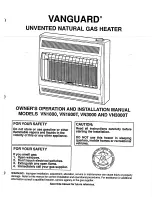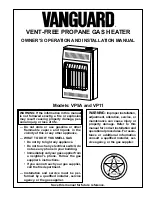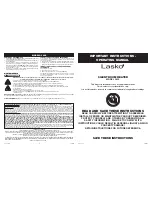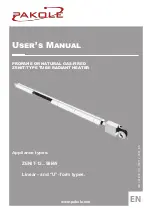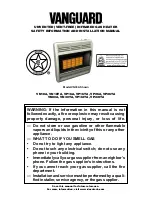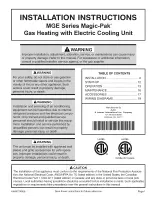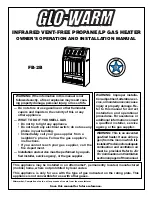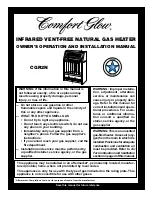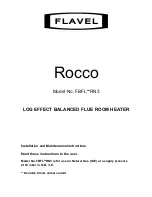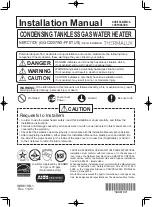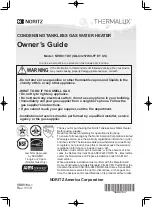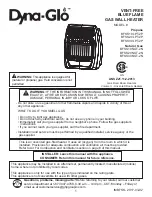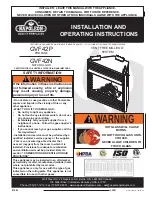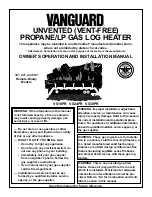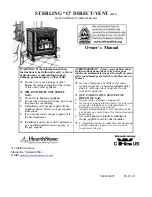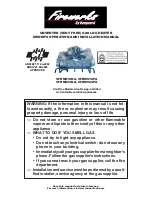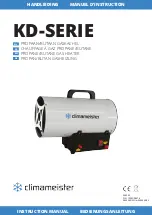
Direct fired heaters discharge combustion by-products with
the heated air in to the area being heated. These include
CO, CO
2
, NO, NO
2
, and Ethylene. These gases can result in
harm to the worker or the plants.
This greenhouse heater has been specificallyveloped for
very low levels of these combustion by-products. However,
it is necessary to have an exchange of air within the
greenhouse to avoid accumulation of these gases to a
harmful level over an extended period of operating time.
Greenhouses have a natural air leakage factor. This natural
leakage is influenced by the design and physical condition
of the greenhouse as well as wind conditions and other
factors. This natural leakage factor can not be relied upon
as being sufficient to provide the necessary air exchange
within the greenhouse. Proper installation of this heater
must include provision for adequate air exchange as
follows:
Indoor Mounted Heater:
■
An exhaust fan capable of providing at least 595
m3/hour of discharge air.
■
An inlet shuttered louver of at least 774 sq.cm.
area.
■
The inlet shutters must be electromachanically
operated and electrically interlocked with the
heater such that the heater can not operate if the
inlet shutters do not open when heating is
required.
■
Refer to Indoor Ventilation Requirements in this
manual.
Outdoor Mounted Heater:
■
An exhaust shuttered louver of at least 645 sq. cm.
area.
1.
Read all safety precautions and follow L.B. White
recommendations when installing this heater. If
during the installation or relocating of heater, you
suspect that a part is damaged or defective, call a
qualified service agency for repair or replacement.
2.
Make sure the heater is properly positioned before use
and is hung level. Observe and obey all minimum safe
distances of the heater to the nearest combustible
materials. Minimum safe distances are given on the
heater nameplate and on page 4 of this manual.
3.
The heater may be used either indoors or outdoors.
For heaters intended for outdoor installation, the
heater is to be installed at least 45.7 cm. above the
ground or to a height that would prevent snow
blockage of heater’s air inlet. Refer to instructions
provided in the optional L.B. White outdoor mounting
and ducting kit, part number 23579.
4. The heater must have the proper gas regulator installed
for the application. A regulator must be connected to
the gas supply so that gas pressure at the inlet to the
gas valve is regulated within the range specified on the
dataplate at all times. Contact your gas supplier, or the
L.B. White Co., Inc. if you have any questions.
5.
The heater’s gas regulator (with pressure relief valve)
s h o u l d b e i n s t a l l e d o u t s i d e o f b u i l d i n g . A ny
regulators inside the buildings must be properly
vented to the outside. Local, state and national
codes always apply to regulator installation. Natural
gas regulators with vent limiting device may be
mounted indoors without venting to outdoors.
6.
All gas pressure regulators must be installed in strict
accordance with the manufacturer’s safety instructions.
These instructions accompany each regulator.
7.
Insure that all accessories that ship within the heater
have been removed from inside of heater and
installed. This per tains to air diver ters, hose,
regulators, etc.
8.
Make certain that a sediment trap is installed at the
gas valve inlet to prevent foreign materials (pipe
compound, pipe chips and scale) from entering the
gas valve. Debris blown into the gas valve may cause
that valve to malfunction resulting in a serious gas
leak that could result in a possible fire or explosion
causing loss of products, building or even life. A
properly installed sediment trap will keep foreign
materials from entering the gas valve and protect the
safe functioning of that important safety component.
9.
Any heater connected to a piping system must have
an accessible, approved manual shut of f valve
installed within 1.83 m. of the heater it serves.
10.
Check all connections for gas leaks using approved
gas leak detectors. Gas leak testing is performed as
follows:
-- Check all pipe connections, hose connections,
fittings and adapters upstream of the gas
control with approved gas leak detectors.
-- In the event a gas leak is detected, check the
components involved for cleanliness and
proper application of pipe compound before
further tightening.
-- Furthermore tighten the gas connections as
necessary to stop the leak.
-- After all connections are checked and any
leaks are stopped, turn on the main burner.
-- Stand clear while the main burner ignites to
prevent injury caused from hidden leaks that
could cause flashback.
-- With the main burner in operation, check all
connections, hose connections, fittings and
joints as well as the gas control valve inlet and
outlet connections with approved gas leak
detectors.
7
Installation Instructions
GENERAL
WARNING
Fire and Explosion Hazard
■
Do not use open flame (matches, torches, candles,
etc.) in checking for gas leaks.
■
Use only approved leak detectors.
■
Failure to follow this warning can lead to fires or
explosions.
■
Fires or explosions can lead to property damage,
personal injury or loss of life.
























